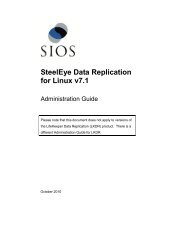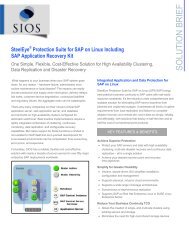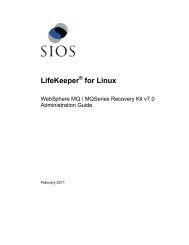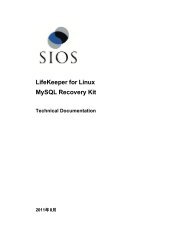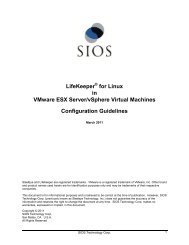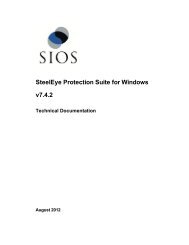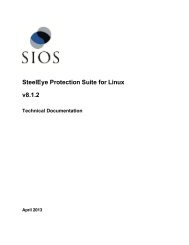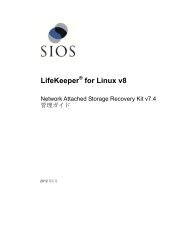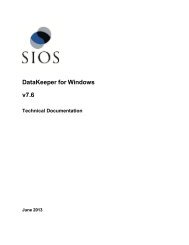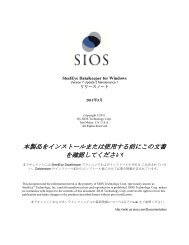Resource Hierarchies - SIOS
Resource Hierarchies - SIOS
Resource Hierarchies - SIOS
You also want an ePaper? Increase the reach of your titles
YUMPU automatically turns print PDFs into web optimized ePapers that Google loves.
<strong>Resource</strong> <strong>Hierarchies</strong><br />
SPS performs this check only once, after all comm paths go down. If the safety check detects that<br />
the system is alive, failover is aborted. SPS does not re-initiate failover until all of the following events<br />
happen in sequence:<br />
1. At least one of the comm paths comes back ALIVE.<br />
2. All comm paths again go DEAD.<br />
3. The safety check activates and does not detect that the paired system is alive.<br />
<strong>Resource</strong> <strong>Hierarchies</strong><br />
The LifeKeeper GUI enables you to create a resource hierarchy on one server and extend that<br />
hierarchy to one or more backup servers. SPS then automatically builds the designated hierarchies<br />
on all servers specified. SPS maintains hierarchy information in a database on each server. If you use<br />
the command line interface, you must explicitly define the hierarchy on each server.<br />
After you create the resource hierarchy, SPS manages the stopping and starting of the resources<br />
within the hierarchy. The following topics provide background for hierarchy definition tasks:<br />
• <strong>Resource</strong> States<br />
• Hierarchy Relationships<br />
• Shared Equivalencies<br />
• <strong>Resource</strong> Hierarchy Information<br />
Hierarchy Relationships<br />
SPS allows you to create relationships between resource instances.The primary relationship is a<br />
dependency. For example, one resource instance depends on another resource instance for its<br />
operation. The combination of resource instances and dependencies is the resource hierarchy.<br />
In the example above, MSExch.0 is an Exchange resource, which has three dependencies - a DNS<br />
resource (DNS.0) and two volume resources (Vol.L and Vol.X).<br />
The dependency relationships specified by the resource hierarchy tell SPS the appropriate order for<br />
bringing resource instances in service and out-of-service. In the example resource hierarchy, SPS<br />
cannot bring the MSExch.0 resource into service until it successfully brings into service the DNS<br />
and volume instances.<br />
SteelEye Protection Suite for Windows 7



